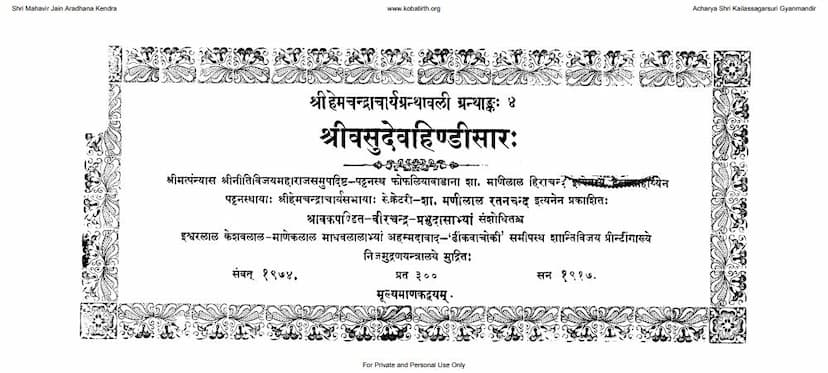Vasudevhindi Sar
Added to library: September 2, 2025

Summary
This is a comprehensive summary of the provided Jain text, "Vasudevhindi Sar" by Veerchand Prabhudas Pandit:
Introduction and Editorial Context:
The document is a published edition of "Vasudevhindi Sar," a Jain text, prepared by the Shri Mahavir Jain Aradhana Kendra. The original text was found in a library under the supervision of Sh. Halabhai Maganbhai of Patan. The discovered manuscript was generally considered impure and contained approximately 250 shlokas (verses).
The introduction highlights the "Vasudev Hindi" as a gem in Indian literature, particularly esteemed within the Jain community. It expresses the desire to satisfy the curiosity of those interested in its subject matter, acknowledging that fulfilling this requires significant resources. The current "Sar" (essence/summary) is presented as a brief outline of the larger work.
About the Original "Vasudev Hindi":
- Significance: The "Vasudev Hindi" is described as a significant literary work, considered a treasure in Indian literature.
- Authorship and Dating: The author and the exact period of its compilation are not definitively known. The text mentions "Shri Gunagnidhan Muni wrote the story briefly," but the identity of this Muni is unclear. Based on its style and content, the manuscript is estimated to be no older than 300-400 years.
- Content and Structure: The original "Vasudev Hindi" is a vast work, estimated to be around twenty-four to twenty-five thousand shlokas. The current "Sar" is a condensed version with about 250 shlokas. The original text is believed to have had 171 "lambhakas" (chapters or sections), but the completeness of the surviving parts is uncertain.
- Comparison to Brihatkatha: It is compared to Gunadhya's "Brihatkatha" (written in Paisachi language), which narrated the life of King Naravahana. The "Vasudev Hindi" is said to narrate the life of Vasudeva in Prakrit language. The original "Brihatkatha" is now rare, and only portions of the "Vasudev Hindi" are available.
- Fragments and Missing Parts: Available fragments are found in libraries of Patan, Radhapur, and Ahmedabad, forming three sections. There's speculation about a potential fourth section, which might have become lost or unseen in the last 150-200 years, as a note in an Ahmedabad library mentioned a "fourth section of Vasudev Hindi."
- Literary Merit: The prose is described as pleasant and serious, with natural use of verbal ornamentation. The writing style is said to be reminiscent of Jain Agamas. The language is compared to that of "Saraswatichandra" in its ease and enjoyment for a Gujarati reader with a moderate understanding of Sanskrit and Prakrit. The text is praised for its literary qualities, making it not only a credit to Jain literature but also deserving a place among excellent ancient Indian literary works.
- Historical and Religious Significance: The publication of this text is expected to shed light on history, language, and Jain customs and practices.
The "Vasudevhindi Sar" (The Present Edition):
- Purpose: This edition aims to provide a condensed version of the "Vasudev Hindi" to cater to the demand from readers, despite the difficulty in gathering and cross-referencing multiple manuscript versions due to time constraints.
- Title: The title "Vasudev Hindi Sar" is used in this publication, while a noted scholar, Maharajshri Kantivijayji, had previously referred to a work as "Vasudev Hindi Alapaka." The original text concludes with "Vasudev Hindi Katha Samapta."
- Editor's Plea: The editor acknowledges the potential for errors due to the manuscript's impurity and the difficulties faced during research, requesting learned individuals to correct any perceived mistakes.
Content of the "Vasudevhindi Sar" (Summary of the Narrative):
The provided pages present the narrative of Vasudeva's life, interspersed with Jain philosophical and devotional elements. Key plot points and characters include:
- The Story Begins: The narrative starts with King Samudravijaya in Kosambi and his wife Vanmala. It mentions the birth of a being who will seek revenge, hinting at future conflicts. King Virya, in sorrow, is reborn as a celestial being.
- Vasudeva's Birth and Upbringing: Vasudeva is born to King Samudravijaya and his wife Ramadevi. He grows up strong and skilled.
- Kansa's Rise: Kansa, the son of King Ugrasena, is portrayed as ambitious and takes over the kingdom, imprisoning his father.
- Vasudeva's Marriage to Rohini and Devaki: Vasudeva marries Rohini and later Devaki.
- The Prophecy: A prophecy indicates that Devaki's seventh son will be the destroyer of Kansa.
- Kansa's Cruelty: Kansa, fearing the prophecy, tries to eliminate Devaki's children. He kills several of them, and other divine interventions occur to protect the children.
- The Birth of Krishna and Balarama: The text details the birth of Krishna and Balarama, their upbringing, and their eventual confrontation with Kansa.
- Key Events: The narrative covers significant events like Krishna and Balarama's battles with various demons and warriors, their return to Mathura, the defeat and killing of Kansa, and the subsequent restoration of Ugrasena to the throne.
- Vasudeva's Other Children: The text also mentions Vasudeva's other children and the events surrounding their lives.
- Neminatha's Connection: There's a mention of Lord Neminatha's story being part of the "Vasudev Hindi," and it is suggested that Acharya Hemachandra drew from the "Harivamsa Shastra," which might be the "Vasudev Hindi" itself.
- The Narrative Style: The story is presented in Prakrit, with a detailed and engaging narrative that includes events like Vasudeva's journeys, battles, marriages, and the complex relationships between the characters. The text also incorporates elements of Jain cosmology and philosophy.
Overall Purpose and Appeal:
The "Vasudevhindi Sar" aims to preserve and disseminate a significant Jain literary work. It highlights the historical, linguistic, and cultural importance of the original "Vasudev Hindi" and offers a glimpse into the epic story of Vasudeva, his divine son Krishna, and their roles in the Jain tradition. The text emphasizes the literary artistry and the devotional aspects, making it a valuable resource for those interested in Jain literature and its rich heritage.